The calculator below is for authentic Neapolitan pizza dough recipes. If you are unsure, you can leave everything and just change the number of pizzas. A dough weight of 250g should produce roughly a 10 inch pizza.
Notes:
For more information on adjusting the recipe, keep on reading.
Not all the following utensils are required but these are what I use and they tend to make the process easier.
I’ve provided Amazon links for you to check the prices of these items if you don’t have them already. They are usually available for reasonable prices.
Large mixing bowl
Metal mixing bowls are lightweight, stackable, and easy to clean.
Digital weighing scales
These are affordable, easy to use, and very precise (accurate to 1g).
Accurate digital weighing scales
Scales accurate to 0.01g are perfect for weighing the tiny amounts of yeast required for long proves.
Pizza proofing box
Pizza proofing boxes are an excellent investment, especially if you intend on holding pizza parties at some point!
Stick Blender
With a stick blender, you can blend the tomatoes in a bowl and the clean up takes no time at all.
12″ pizza peel
A 12 inch peel is ideal for Neapolitan pizza and makes loading and removing your pizza from the oven easy.
This dough calculator has been designed specifically for making Neapolitan style pizza. That means that no matter how you change the inputs, you have an authentic Neapolitan pizza style recipe.

I have read through the official Neapolitan document very carefully. It specifies many things, including: amount of water (hydration), amount of salt, amount and type of yeast, and prove time and temperature.
If you want to check out the official documentation, you can take a look at it here.
It is also recommended that a strong 00 flour is used (though you can achieve good results with strong bread flour). The type of water used is also mentioned (medium-hard), though I wouldn’t worry about this unless have particularly poor quality tap water. In which case, you should probably at least filter it or use bottled water.
Note: Caputo 00 pizza flour is an excellent option, especially for Neapolitan style pizza. It is one of the more widely available “professional” pizza flours. I have provided a link to Caputo 00 flour on Amazon here and below below (a large chef’s bag). Aside from this flour, most 00 flours should work fine.
There are quite a few variables that you can change in this pizza dough calculator, which will affect the quality of the pizza that you make.
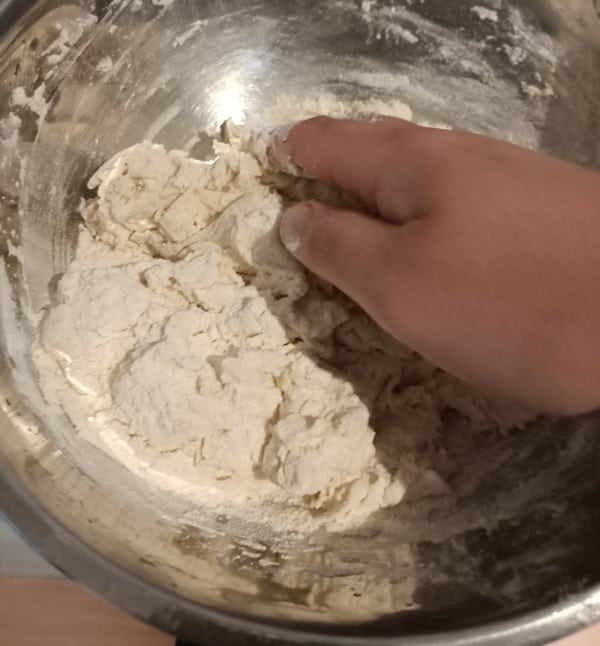
In this section I will do my best to explain what each of these and how you can adjust them to help you make better pizza.
If it’s your first time making Neapolitan pizza, I highly recommend checking out my series (with videos) on making authentic Neapolitan pizza by hand here.
The dough weight is fairly straight forward really. The higher your dough weight, the larger your pizza will turn out.
For Neapolitan pizza, the dough weight should be between 200g – 280g. Pesonally, I have found a good sweetspot to be around 240g – 260g. This should give you roughly a 10 inch pizza. But feel free to experiment to find out what works for you (and the size of your oven).
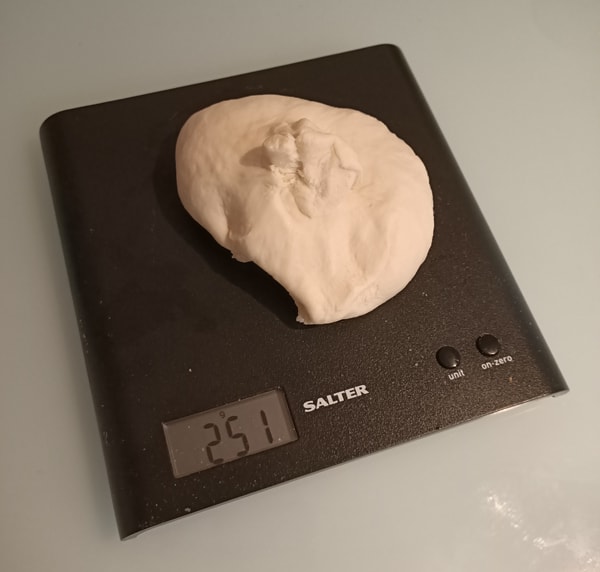
This will depend largely on how you shape your pizzas. If you opt for very puffy crusts, you will need a higher dough weight to achieve a 10 inch pizza.
On the other hand, if you opt for smaller crusts, your dough weight won’t need to be quite as high. Whichever style of crust you make, you should always try to stretch a Neapolitan pizza as thin as possible in the centre. This is central to the Neapolitan style.
The hydration is one of the most important aspects of your pizza dough. It refers to the amount water used (as a %) in relation to the amount of flour used (in g).
The higher the hydration, the wetter, stickier, and softer your dough will be. The lower the hydration, the drier, firmer, and stronger your dough will be.
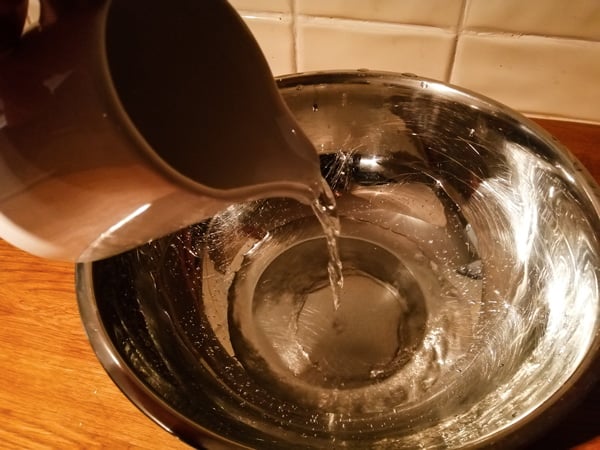
There is no correct amount here, you will need to use some trial and error. But 55% – 62% is the amount mntioned in the official Neapolitan pizza document. Bear in mind that this is based on the use of 00 flour. When using bread flour, you will likely need to be at the higher end of this range.
Each flour behaves differently, even within the same type. For example, a hydration that works well for one brand of 00 flour, may not work well for a different brand of 00 flour. However, in general, I have found 55% – 58% to be a great starting point for 00 flours.
In my opinion, lower hydrations are more suited to beginners. A drier dough is easier to knead, easier to shape, and more forgiving. So if you’re new to making Neapolitan pizza, I would recommend leaning more towards a drier dough.
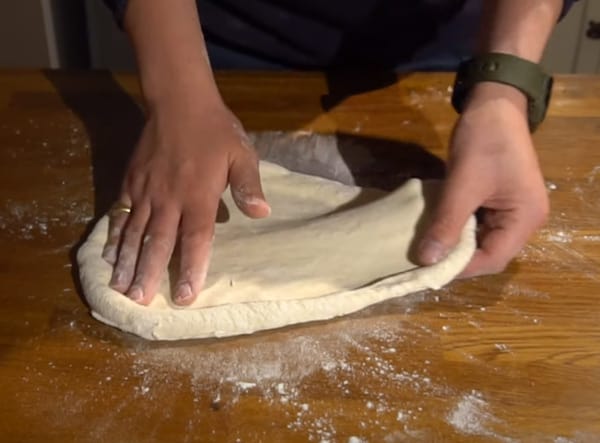
Many people assume that a dry dough cannot achieve a light and airy crust but this is not true. The extreme heat that Neapolitan pizza is cooked at, causes a lot of expansion in the dough. This, in turn, leads to a soft and puffy crust.
Additionally, a Neapolitan pizza should be very thin in the centre (and thicker at the crusts). If the hydration is too high, the pizza will not have the strength to be stretched out this thin.
It always surprises me that people assume that Neapolitan pizza should be over 65% hydration but this is simply not the case. It may work well for some flours and production methods but in general, it is way too high for this style of pizza. In fact, it is way outside the range recognised in the official Neapolitan documentation.

So, as a general rule, I would recommend 56% as a starting point for 00 flour and 60% as a starting point for bread flour. I highly recommend using 00 flour though if possible.
For more information, check out my article on pizza dough hydration here.
The recommended amount of salt for Neapolitan pizza is between 2% – 3%.
Personally, I find anything approaching 3% too salty and anything below 2% too bland. For me, the sweetspot is around 2.2% – 2.5%. But, of course, experiment with this and find out what you like.
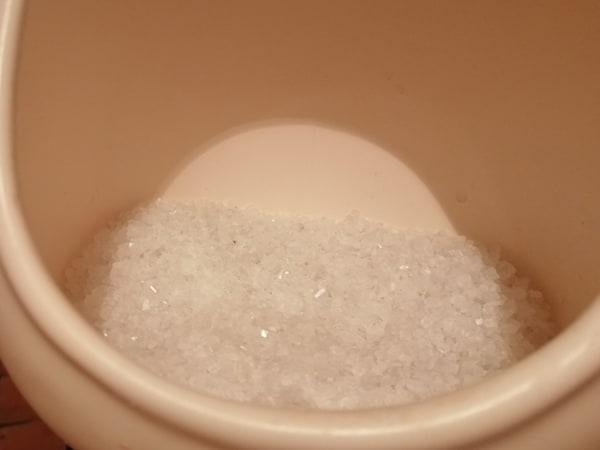
Don’t be worried about too much or too little salt affecting the structure of your dough. At the 2% – 3% range, the salt will have very little affect on the structure of your dough.
The proof time mentioned in the official Neapolitan document is anything between 8 hours and 24 hours. You can choose a time that is convenient for you (and the yeast!).
In general, a longer prove is preffered since your dough should develop more flavour, a better texture, and will be more forgiving to work with. Anything under 8 hours may seem more convenient but the dough will actually be more difficult to work with, it will have a high chance of overproving, and won’t have the same flavour or texture.
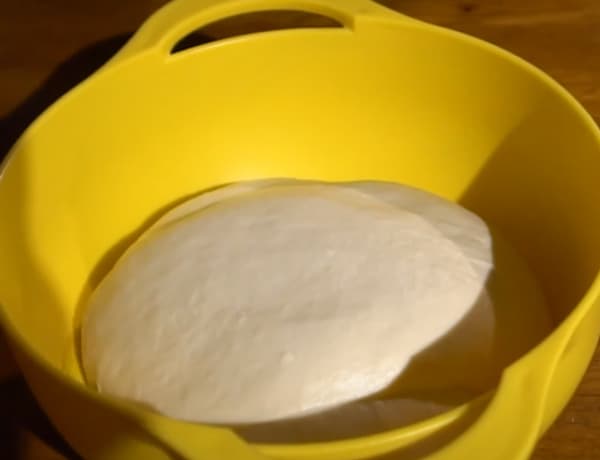
I know that many people choose to do a prove that is even longer than 24 hours. However, this is not recommended since most flours are not strong enough to withstand a fermentation (prove) longer than 24 hours.
After 24 hours, most flours start to loose their strength. The dough becomes difficult to stretch and easy to tear.
However, there are some specialist Neapolitan long prove flours which can do the job. But unless you have one of these, I would recommend sticking to a 24 hour prove maximum.
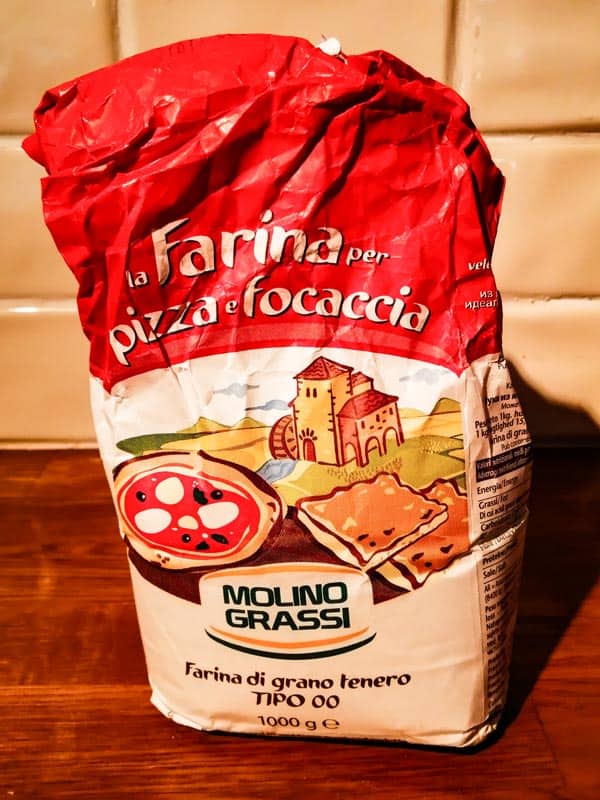
In general, I recommend a 24 hour prove. This is not just for the benefits in terms of flavour and texture. Additionally, it should be easy to fit into your daily routine.
For example, let’s say you want to make pizza at 7pm on Saturday night. You can make the dough at 7pm on Friday night and it will be ready the next evening. Perfect!
The recommended proofing temperature for Neapolitan pizza is room temperature. In the official document, a room temperature of between 13C/55F – 33C/91F is mentioned as being acceptable. This is based on the optimal temperature for yeast growth (fermentation).
A thermometer is handy to take the temperature of your room. You can then enter this value into the calculator and let it do the rest. If your room is cold you will need more yeast and if it is hot you won’t need as much.
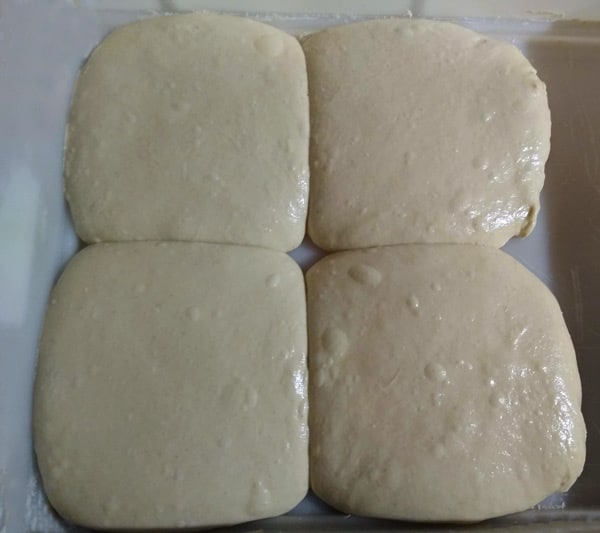
I can highly recommend pizza proofing boxes. They make proofing your dough so much easier, especially if you’re planning on doing pizza parties and making a lot of pizza! There’s a link to some on Amazon below.
And don’t forget to prove your dough out of direct sunlight! Too much heat can kill the yeast or cause overproving.
I realise that it has become popular to cold proof dough. However, a lot more yeast is required to account for the significantly reduced efficiency. Although there are advantages to cold proving (constant temperature), there are also disadvantages (inefficient yeast development, faster proofing once out of the fridge).
And since cold proving is not mentioned in the official Neapolitan document, I have opted to leave it out for now. Personally, I think the best option is to proof at room temperature. As long as you don’t have huge changes in temperature in your room, you shouldn’t experience any timing issues.
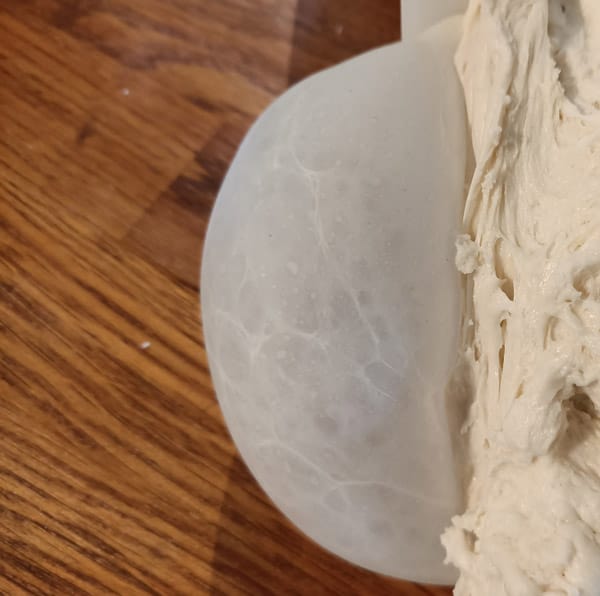
Having said that, with any dough making, it is wise to follow the old saying: “watch the dough, not the clock”. Whilst this calculator should get you very close on the timings, it will never be exact as there are too many variables!
Fortunately, practically every type of yeast is mentioned as being fine to use in the official Neapolitan pizza document. This includes:
The most commonly available is dried yeast. It is available in most supermarkets. And this is cheap, lasts a long time, and works fine. Bear in mind that their is a slight difference between Instand Dried and Active Dried so check the packaging to see which you have.
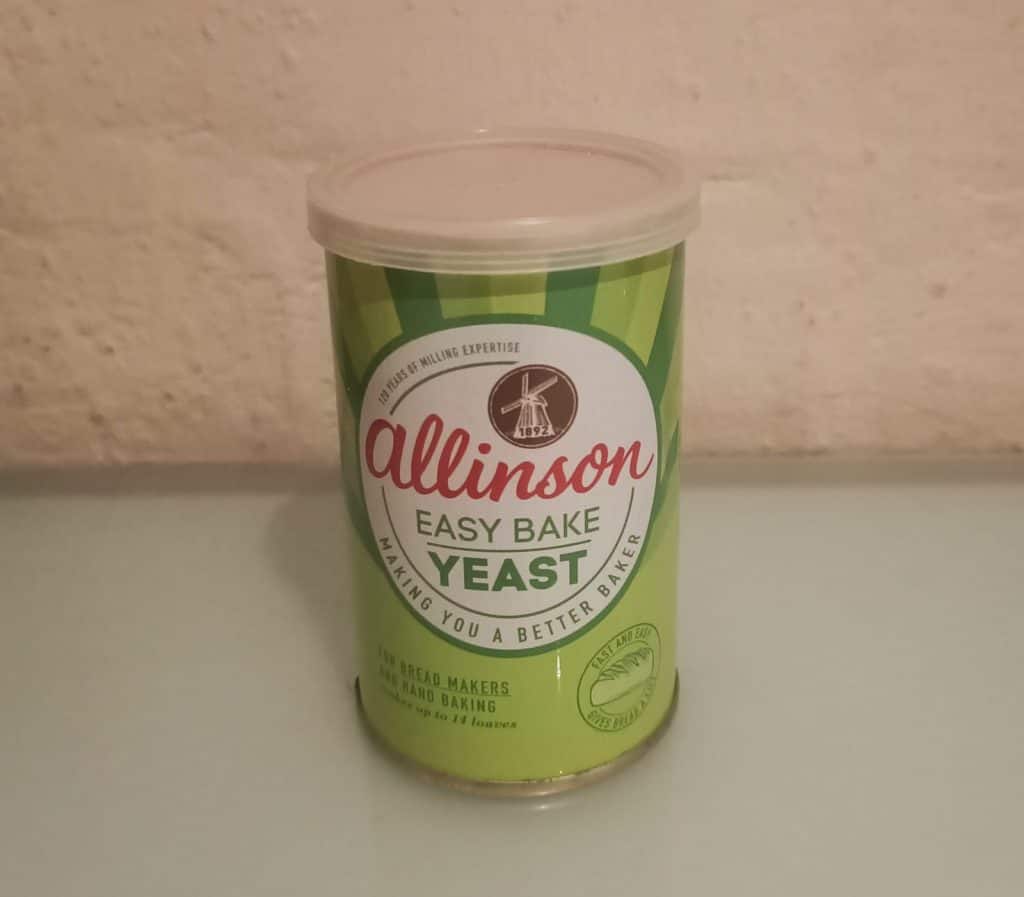
In my view, the nicest yeast to use is Fresh Yeast, or Cake Yeast (due to it’s appearance) as it is sometimes called. This yeast is quite difficult to get hold of (but you can get it online) and it doesn’t last very long (though you can freeze it).
But Fresh Yeast typically offers more flavour. I find it to sit somewhere between dried yeast and sourdough in terms of flavour. It is almost like a milder form of sourdough, which I think works really well for Neapolitan pizza. It is also the most widely used form of yeast in pizzeries in Naples, so it is probably the most authentic choice.
If you want more information on this, you can check out my article on fresh yeast here.
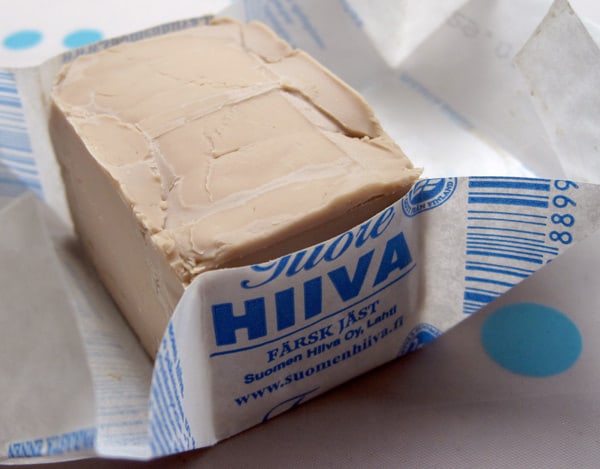
You could use sourdough starter but I haven’t included this in the calculator. Sourdough is much more difficult to work with and the timing will depend so much on each individual starter. This is because each starter is a collection of completely different strains of yeast.
I have had a few people ask me about sourdough so I plan to do a series on it in the future. For anyone that hasn’t worked with sourdough before but wants to, I highly recommend giving poolish a go first. I have done an article on poolish which you can check out here.
In short, just use whichever type of yeast you can get holf of. Dried yeast works fine, is cheap and easy to get hold of, and it lasts a long time. So it’s a good choice.
Hopefully this pizza dough calculator provides an excellent starting point to your recipe. Simply starting out with the calculator defaults will get you close to a great pizza dough recipe (assuming you’re using 00 flour).
Then, you can adjust the inputs depending on how your dough turned out. Next time you may want to adjust the hydration or salt content or prove time etc.

Remember, this calculator is not perfect. There are too many variables to produce a perfect pizza dough calculator. A lot will depend on: your specific yeast, and how fresh/active it is, the specific flour you use, your water, the humidity of your room, and so on.
I recommend using this calculator as an aid which should get you very close to the perfect dough. From there, you can then dial it in. And remember, “watch the dough, not the clock”. The dough will tell you when it’s proved.
It should have doubled in size and be nice and bubbly.
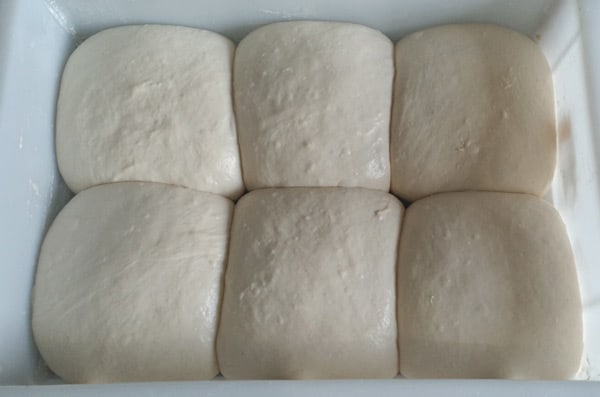
Hope this helps some people out. Feel free to leave any questions below, I do my best to answer any queries as quickly as possible.
Good luck!

I’m Tom Rothwell and I’m super passionate about all kinds of homemade pizza! In the last few years I've been on a quest to find the perfect pizza. Now I'm sharing what I've found out with the world!

If you're interested in hiring me for your event in the UK, feel free to check out my website with the link below.
Pizza Catering
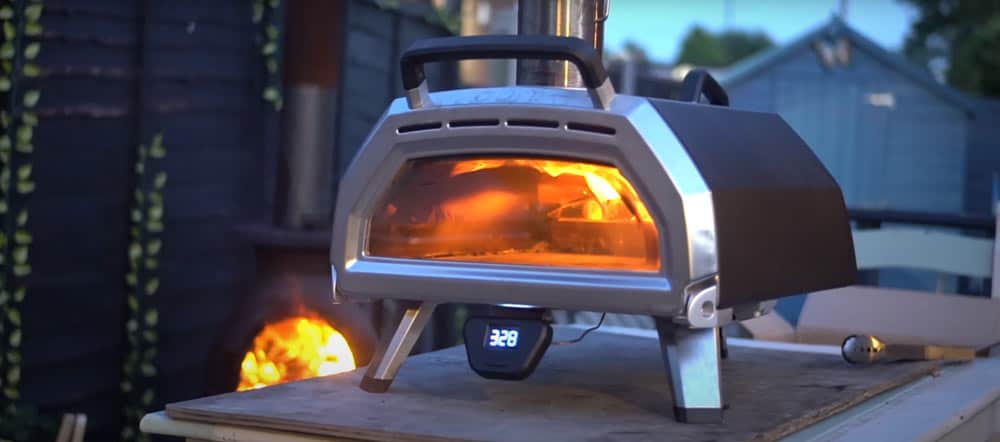
I often get asked what type of oven I use for my pizzas. Well, I use a pizza oven made by a company called Ooni.
The range of pizza ovens that Ooni offers is just brilliant. They cover all bases, and all price points. There's affordable and portable models such as the Fyra 12 Pizza Oven and then there's state-of-the-art models such as the Karu 16 Pizza Oven pictured below.
In all honesty, I would say that the oven makes a huge difference. If you're looking to make authentic Italian pizza, a pizza oven is a must.
By clicking the link below and purchasing from Ooni, you would be supporting this website. I've been using their ovens for a long time now and I wouldn't recommend them if I didn't believe in their products.
Time to make some amazing pizza!

I’m Tom Rothwell and I’m super passionate about all kinds of homemade pizza! In the last few years I've been on a quest to find the perfect pizza. Now I'm sharing what I've found out with the world!

If you're interested in hiring me for your event in the UK, feel free to check out my website with the link below.
Pizza Catering
Loved using your poolish recipe, but can’t seem to replicate the quantities for that on this calculator. The closest I can seem to get with the same Ingredients and temperature is with a yeast reduction of c.30% (have tried both idy and ady). How would you set the calculator to get same results as your poolish recipe? Thanks in advance
Glad you like the recipe Matt and good question. At the moment, the pizza dough calculator doesn’t include an option for poolish but it may be something I look to add in the future.
Poolish is a very different method to regular dough (direct dough), you are effectively proving your dough twice. As a rule of thumb, around 0.2% instant yeast when compared to the weight of flour in the poolish is a good amount to use (this is using the baker’s percentage method). So this equates to 0.6g in the poolish recipe you mentioned.
In the recipe, I also recommended 50% poolish (compared to total flour weight). So to make calculations for poolish, you can first use the calculator above to get your overall ingredients. Then, use half the amount of flour for the poolish, along with an equal amount of water. You will need to subtract these values for poolish flour and water from your overall ingredient quantities.
Then calculate 0.2% of the weight of flour in the poolish and add this much yeast (multiply flour in poolish by 0.002). Eg 300g * 0.002 = 0.6g instant yeast.
Once the poolish has proved you can simply add the remaining flour and water, along with the salt. (And then prove your dough again, of course).
Hope this has helped!
0.6g of instant yeast is less than 1/3 teaspoon. Is that enough? Every other recipe I use tells me to use much more even for a 24hr proof.
Hi Jeffrey, yes that’s the right amount for a 24 hour prove at room temperature, which is the optimal temperature for yeast. Thanks for the question!
What about for somebody who cannot eat wheat? I need to follow a Paleo diet? Flours I use would be a mix of coconut, almond flour, tapioca or arrowroot starch. I miss eating pizza so much!! I just learned through this post to leave the dough overnight. I have never heard of that, but it makes so much sense.
Hi Catherine, yes resting the dough and proving it over night works wonders for the dough.
For people who cannot eat wheat, there is a gluten free flour from Caputo which works well and can be used in much the same way as regular flour. I’m planning an article on this soon so stay tuned!
Thank you
Thank you so much it was very helpful and easy to understand.
Awesome…..
Thanks Vic! I’m glad you found it useful!
Hey, I’ve been using your calculator for months now. Great recipe.
Are you able to add hydration levels up to 70% in your calculator? For those wanting to experiment with higher levels of hydration.
Regards, Daniel
Hi Daniel, good question. The reason I haven’t added the higher levels of hydration is that I’ve found people to go too high, in general.
This often leads to weak dough that is difficult to shape, often resulting in a thick and doughy pizza. High hydration is also not strictly Neapolitan.
But maybe I could incorporate an “Advanced” option for those that want to experiment. I guess this could make it clear that higher hydrations are only for very experienced pizza makers?
Thanks for the question!
Thanks for your work!
I agree with the previous comment, I have used the Caputo 00 Pizzeria flour up to 70% hydration, and although more difficult to shape, the pizza turned out great.
Allowing people to experiment outside the “safe range” would be great!
Thanks
Hi Gian, thanks for the comment, I’ll consider adding an advanced feature.
However, my goal is to get people making amazing pizza as quickly and easily as possible so I’m reluctant to provide that option. I would hate to start people off on the wrong foot, so to speak.
Also, I have an article on pizza dough hydration here and an article on baker’s percentage here.
Once you understand how baker’s percentage works, you can create pizza recipes with whatever hydration you want. I would highly recommend understanding this first before experimenting with more advanced recipes.
Cheers
Hello, Thank you for all the great info. I will try some of your suggestions and will experiment what is best for me.
The pizza shops who would share with me their hydration for their pizza uses bread flour or high gluten flour at 48-50% hydration. I use that level with bread flour or all purpose and it comes out real good.
Thank you for all of your knowedge and all the best to you.
Mike Kaplan. PS I use a sourdough with my pizza.
Thanks Michael, I’m pleased you’ve found the site useful. 48-50% hydration sounds very low to me but it’s about finding what works for you. Keep it up! Tom
Tom, thank you for this great calculator. Happy to see you try and respect the Verace Neapolitan standard. The best part of your calculator is the yeast part, with the temperature, and the number of hours, Bravo!
If you ask me, the only part about the calculator you got wrong is the salt. I agree with your comment on the sweet spot being at 2.3% – 2.4 %, but the official guideline calls for 2,5% to 3.5%.
Finally, can we expect an app?! That would be so great!
Many thanks!
Hi Jeff, I’m pleased you like the calculator. I have considered an app but there are no plans for this as of yet.
With regards to the salt, the minimum amount recommended is actually 2.2% but I realise that it can be increased.
When I have tried higher than 2.5%, it seemed very salty to me (and others), and I am someone who loves salt!
I didn’t want to encourage people to use too much salt for them to find out that they don’t like the dough. Although I take your point, perhaps I could increase the options.
Thank you!
Hello,
I have already made two pizzas based on your recipe, thank you 🙂
But I have an important question:
– In your “EASY POOLISH PIZZA DOUGH RECIPE” you wait for 10h for your poolish and 10h for your dough
– In this “Neapolitan Pizza Dough Calculator” calculator, you only have the Proof Time variable to choose from.
As a beginner, I don’t know whether Proof Time in the calculator means:
1. 10h in calculator = 10h for poolish and 10h for dough
2. 10h in calculator = 5h for poolish and 5h for dough
Which one is correct? Thanks in advance 🙂
Hi Radek, in the calculator there is no option for poolish currently. The values are for “direct dough”. In other words, you don’t need to make poolish, you can simply mix the ingredients and allow the dough to prove.
This is the easier way to make dough and while poolish may be preferred, the difference isn’t huge. For a beginner, I would recommend sticking to the regular way of making dough before moving onto poolish.
You can check out my recipe for standard Neapolitan dough here (non-poolish) if you haven’t already.
Hopefully this makes sense. Let me know if you have any other questions. Thanks
Hi, thanks very much for all the advices. It’s very helpful.
Cheers from France!
Merci pour les mots gentils Thomas!
I am wondering if there’s any insight into why Ooni’s recipe in their Karu 16 booklet wants us to use so much yeast. That’s the bit I struggle with.
I love the insights, I am learning about proofing for longer, at room temp with less quantity of yeast. There’s a whole new world out there.
Hi Pasquale, for a shorter prove of around 3 or 4 hours, you would generally require around 10 times as much yeast, when compared to a 24 hour prove.
Shorter proves can still make nice dough but typically, a longer prove will produce a dough that is easier to work with and has improved flavour and texture.
Enjoy the wonderful journey that is pizza making!
In the Pizza Dough Ccalculator, is the “Proof Time” before the balling or total?
Hi Marc, I tend to use the “Proof Time” as the total proving time. Of course, you can feel free to experiment and let me know how you get on! Thanks
Curious. How do you keep your dough from drying out when using those proofing boxes? I have one and I don’t use it because of that.
I know some people put oil on the dough but that’s a no no per AVPN.
Hi Michael, I’ve never had an issue with my dough drying out in them. It sounds like yours aren’t fully airtight to me.
Other than using a little oil, you could experiment with using a little water. Although ideally, you’d fix the air leaks I guess.
Thanks for the question!